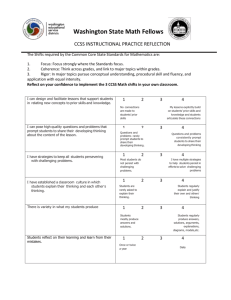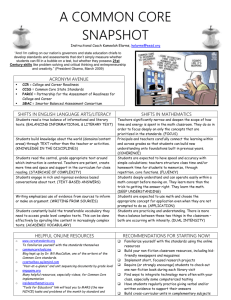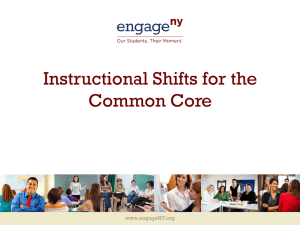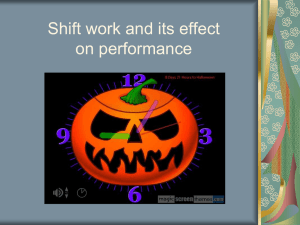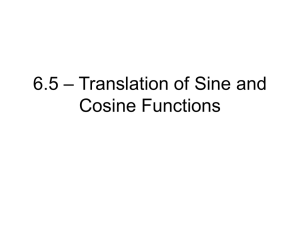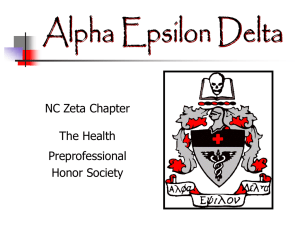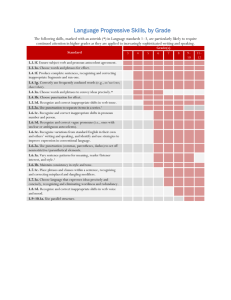College Ready Bar 1
advertisement
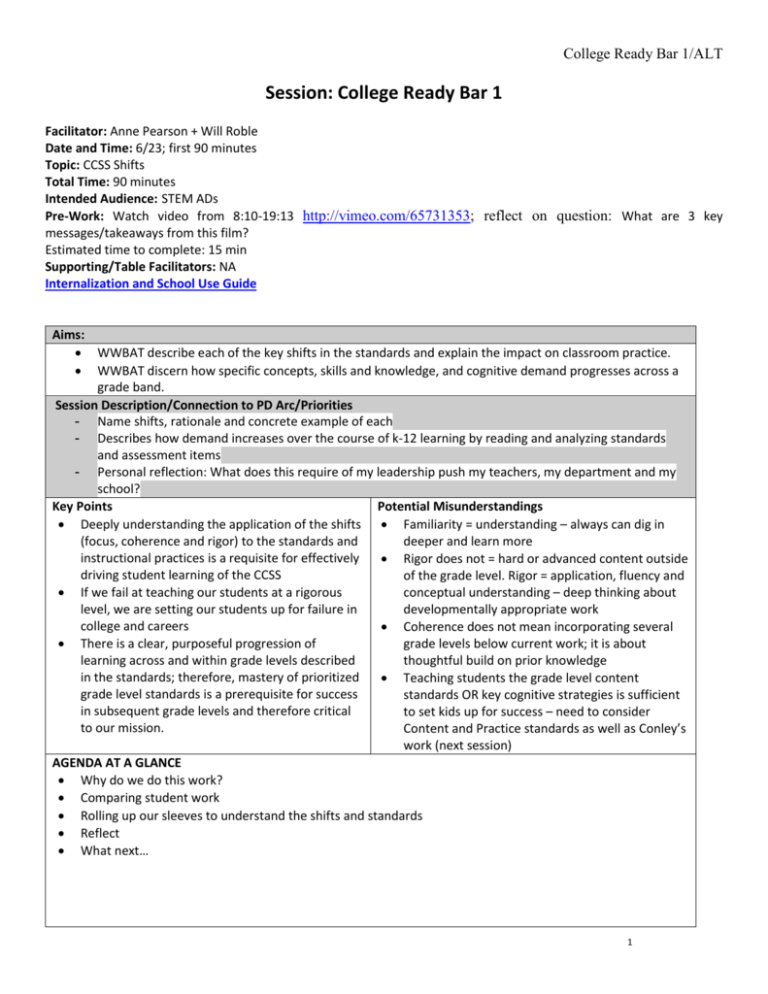
College Ready Bar 1/ALT Session: College Ready Bar 1 Facilitator: Anne Pearson + Will Roble Date and Time: 6/23; first 90 minutes Topic: CCSS Shifts Total Time: 90 minutes Intended Audience: STEM ADs Pre-Work: Watch video from 8:10-19:13 http://vimeo.com/65731353; reflect on question: What are 3 key messages/takeaways from this film? Estimated time to complete: 15 min Supporting/Table Facilitators: NA Internalization and School Use Guide Aims: WWBAT describe each of the key shifts in the standards and explain the impact on classroom practice. WWBAT discern how specific concepts, skills and knowledge, and cognitive demand progresses across a grade band. Session Description/Connection to PD Arc/Priorities - Name shifts, rationale and concrete example of each - Describes how demand increases over the course of k-12 learning by reading and analyzing standards and assessment items - Personal reflection: What does this require of my leadership push my teachers, my department and my school? Key Points Potential Misunderstandings Deeply understanding the application of the shifts Familiarity = understanding – always can dig in (focus, coherence and rigor) to the standards and deeper and learn more instructional practices is a requisite for effectively Rigor does not = hard or advanced content outside driving student learning of the CCSS of the grade level. Rigor = application, fluency and If we fail at teaching our students at a rigorous conceptual understanding – deep thinking about level, we are setting our students up for failure in developmentally appropriate work college and careers Coherence does not mean incorporating several There is a clear, purposeful progression of grade levels below current work; it is about learning across and within grade levels described thoughtful build on prior knowledge in the standards; therefore, mastery of prioritized Teaching students the grade level content grade level standards is a prerequisite for success standards OR key cognitive strategies is sufficient in subsequent grade levels and therefore critical to set kids up for success – need to consider to our mission. Content and Practice standards as well as Conley’s work (next session) AGENDA AT A GLANCE Why do we do this work? Comparing student work Rolling up our sleeves to understand the shifts and standards Reflect What next… 1 College Ready Bar 1/ALT Materials We (including participants) will need: http://vimeo.com/65731353 Doc cam Projector PPT, Handouts Student work To be emailed: Standards Assessment & Follow-up Follow-up by Principals & Deans (dates): Grouping/Physical Space Notes NA Additional Instructions/Notes for Facilitator NA Digest standards: every school leader can and must know their grade band's standards; ADs go through same vertical articulation process completed during PD session for all standards within grade band by start of school. During campus visits, ADs can connect trends they are seeing across their math team with the CC shifts - every two weeks throughout the year (minimum). Living the Learning (LtL) Legend: O= Opening AA= Airtight Activity K= Key Points M= Additional Model A= Application C: Closing/Reflection 2 College Ready Bar 1/ALT Session Detail Time Min. 90 min 13 min Facilitator Notes Aims and Agenda In this session, WWBAT describe each of the key shifts in the standards and explain the impact on classroom practice. WWBAT discern how specific concepts, skills and knowledge, and cognitive demand progresses across a grade band. We will get there by… Why do we do this work? Comparing student work Rolling up our sleeves to understand the shifts and standards Reflect What next… Why do we do this work? The purpose of our next 90 minutes together is to provide the foundation for the next 2.5 days by digging into the shifts and standards through which the shifts live. Hello and introductions – Ice breaker: What is your worst math memory? Frame: We are working on building a math program that helps students to love and appreciate math deeply. As a country we cannot afford to turn kids off from math. To ground ourselves quickly in the urgency and importance of our work, we are going to discuss the video of Uri Treisman, a Calculus professor at UT for longer than any of us have been alive and the head of the UT Dana Center, which you watched as pre-work. T&T – What are the key messages/takeaways from this film? o Key messages: Poverty and Income are the determining facts in math opportunity to learn College remedial programs are burial grounds for student aspirations We have an opportunity to learn gap – and we can fix it Math is the subject that determines whether kids grow up to be adults with choices or not We are going to come back to this question again throughout the session, but we want you to take 2 minutes to write an initial reflection on the following question: What does this require of my leadership to push my teachers, my department and my school? During this session and the next session, we are our goal is to begin the process of clarifying and defining college readiness. Five stops on this journey to create a holistic picture: shifts, standards, course of study, task analysis, proficiency profiles. We will be drawing from the CC content and practice standards as well as from Conley’s work. From Conley’s work, we are specifically focusing on the Key Content Knowledge component of his Four Keys Model to College and Career Readiness. 3 College Ready Bar 1/ALT pg. 55 You might be asking – why are we talking about the shifts and standards, when we have already been working with them for 1-2 years. We are doing so because… o The shifts and standards are the foundation and driving forces for the rest of our work o We are going to look at them through a different lens to understand them on a continuum of learning across k-12 o The shifts and standards are too important to not spend time with Comparing Student Work (AA) - Say: We are going to take a look at some student work to help examine the impact of making shifts in instruction on the outputs that our students are creating. - Examine student work from Alg 2 (no years of CCSS), Alg 1 (one year of CCSS), NY MS Class (two years of CCSS). Say: While examining the work, think about what the shifts in instruction were that lead to the change in quality. - Ask: Based on the before and after, what are the obvious shifts demanded by the CCSS? - Name the shifts with definitions Focus – Learn important content deeply rather than being taught 13 min a broad overview of a number of topics – mile wide and an inch deep. Key implication is we do it once and we do it right. If you see your Ts or ADs rolling in more content outside of the grade level focus and the data doesn’t show that kids are knocking it out of the park, we aren’t spending our time intelligently. Coherence – Mathematical connections between grade levels and within as well as between content and practice standards Coherence does not mean incorporating several grade levels below current work; it is about thoughtful build on prior knowledge 4 College Ready Bar 1/ALT 45 min 17 min Rigor – Conceptual Understanding, Application and Fluency Rigor does not = hard or advanced content outside of the grade level. Rigor = application, fluency and conceptual understanding – deep thinking about developmentally appropriate work - Let’s revisit our initial thinking question and reflect on what do the shifts require of my leadership to push my teachers, my department and my school? - Now that we’re clear on the K-12 shifts, let’s look at how this plays out in the standards themselves Rolling up our sleeves to understand the shifts and standards - 3 min: Challenge issued – as coaches, we need us all to understand the headlines for standards, content of standards and progression of standards. In no way will this be possible in 45 minutes – but given our obligations as instructional leaders and coaches, it should be part of your own learning and commitment this summer. - 30 min: Split ISLs into 4 groups (mix of MS and HS) to follow a strand of learning from k-12 – divide and conquer by having MS review k-8 and HS review 8-12 followed by a share among group members. - Should make sure that folks don’t ONLY look at domains aligned to topics (i.e. Ratios and Proportions don’t only fall under RP, but also are found in F). Say: The topics below do not align to the domains in ES or HS. Therefore, you will have to look at other standards in related domains to capture the learning that leads up to or beyond the more focused learning in MS according to the domains. Also, within the MS grade levels, don’t restrict yourself to the domains in which these topics fall as other domains also contribute to students’ learning. Group 1 – Expressions Group 2 – Ratios and Proportions Group 3 – Equations Group 4 – Statistics – Analyzing Data Work product – summarize for the group what you learned in terms of how students’ knowledge and skills develop using any visual you would like. Guiding questions: How does the learning progress from k-8? 8-12? What are the major links between MS and HS? - 10 min: 2-3 groups present (prioritize in this order – groups 4, 3, 2). If we don’t get to group 2, Anne asks direct question of group 2 – what is the significance of RP understanding to Functions and Equations in grade 8 and HS? - 2 min: Let’s revisit what we have written so far and continue to reflect: Given the progression of learning throughout the standards, what are the implications for my leadership to push my teachers, my department and my school? Reflect 10 min - Say: We are now going to dig in some more and look for connections across the shifts and the standards by examining actual problems aligned to the standards. We will focus in on looking at problems aligned to Ratios and Proportions (picked this because it’s more manageable and pulls in EE and SP) - Guiding question: Where do you see evidence of the shifts and standards (content and practice) in the problems? 5 College Ready Bar 1/ALT - *For ADs who are not as familiar with the SMP or for non-STEM SLs in the room, group with more knowledgeable AD Debrief. Share out insights around guiding question 7 min Final round with our big question: What are the implications for the types of experiences your teachers need to have going forward? The vision for your department? Your leadership? 3 min to write - Share out reflections from the session using notes from written reflections. 4 min to share - Key Takeaway: Teaching students the grade level content standards OR key cognitive strategies is not sufficient to set kids up for success – need to consider Content and Practice standards as well as Conley’s work (next session) What Next… - So far, we’ve discussed college readiness in relation to the shifts and the standards. Coming next, we’ll discuss the course of study and proficiency profiles, which are heavily influenced by the shifts, standards and work of Conley, including key cognitive strategies. Conley - Share PD arc for the rest of ISL training and ISL training throughout the school year - 2 min 6 College Ready Bar 1/ALT ADDITIONAL NOTES/REFERENCE: 7 College Ready Bar 1/ALT Internalization & School Use Guide Purpose & Context of this Session: explain the overall goals of this session and how it fits into the larger flow of learning for the summer/year in this area Facilitator Prep: Each facilitator should take the necessary steps to ensure s/he understands the session and is able to deliver the session with clarity, accuracy and confidence. The preparation steps below are recommendations (general and specific to the session where applicable) and recognize that we all have our own mechanisms for preparing sessions. Ultimately, our goal with this basic guide is to assist facilitators in internalizing the session. All Sessions: 1) Read the session in its entirety and preview the powerpoint to get a feel for the flow of the session. 2) Closely read the aims and annotate the session plan for they key moments where the session most leads to these key aims. 3) Consider the potential misunderstandings and note where you might pre-empt those. 4) Read through the session, looking specifically to group directions, participant practice and directions. Visualize how these directions would go to ensure clarity and flow. 5) Script and assign times to your personalized session plan. 6) Practice. Notes for this specific session: Based on the specific session or subject, list the specific preparation steps. For example: 1) Read the relevant text 2) Read the relevant unit 3) Read the TBK, background knowledge 4) Read this article for context. 8

